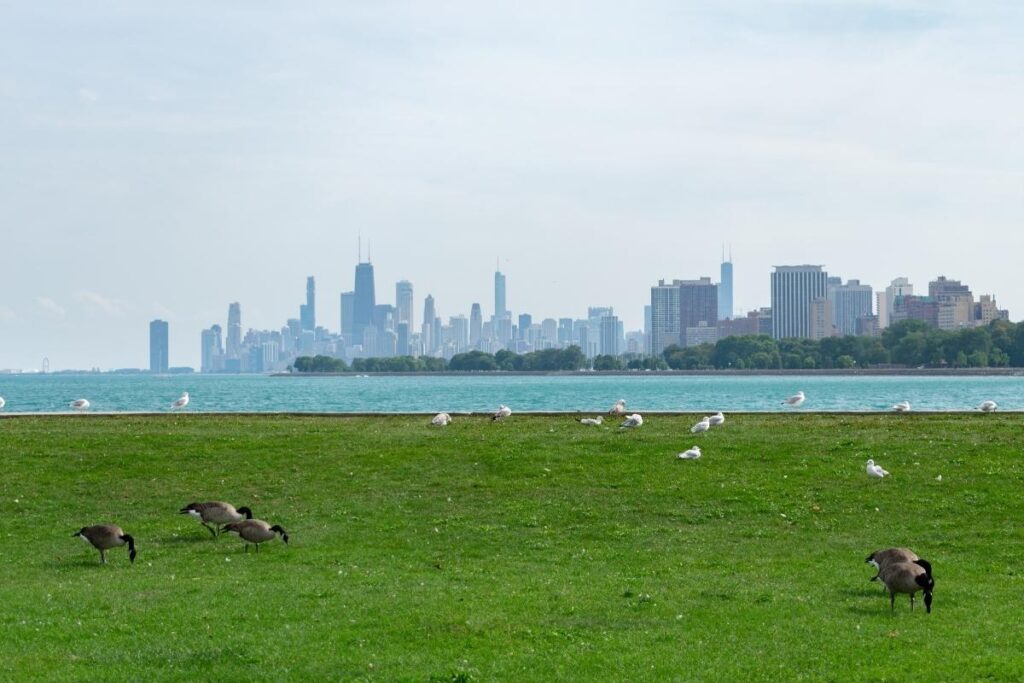
Living or visiting Illinois and wondering what bird you’re looking at? This article covers the most common birds of Illinois. Odds are high the bird you’re looking at is one of them. It will also inform you on how to identify them.
Birding in Illinois
Illinois is a surprisingly wonderful birding destination. Within Illinois’ many state parks are more than 420 different species of birds waiting to be spotted.
Birders can begin with several national parks, such as the Chautauqua National Wildlife Refuge, Prairie Ridge State Natural Area, Crab Orchard National Wildlife Refuge, the Dixon Waterfowl Refuge, and the Shawnee National Forest, where there are masses of birds all year round. Prairie Ridge State Natural Area is grassland that is home to the almost extinct Greater Prairie Chicken. During the spring, birders may spot him doing his mating dance. Hawks, owls, and kestrels, among others, also live here.
Montrose Point by Lake Michigan has over 300 different bird species, the most of any site in the state. During the spring and fall, this is the place to catch migrating songbirds. During the winter months, waterfowl, gulls, loons, and grebes make this their home.
Illinois Beach State Park spans miles around Lake Michigan. The habitat here is diverse, from forests, marshland, to dunes, and is home to 300 species of birds.
North of Peoria, Illinois, the Dixon Waterfowl Refuge has an observation tower and trails to view the waterfowls by the Illinois River and adjacent wetland. There are over 270 species, and the area has been named Wetland of International Importance. This is where to find the American White Pelican, Black-crowned Night Heron, several varieties of wrens and sparrows, and the Yellow-headed Blackbird. During the winter, birders may spot a Greater White-fronted Goose and several species of swans.
Goose Lake Prairie State Natural Area is southwest of Joliet and has wonderful grassland landscaping next to the wetland. The visitor center has an observation deck and information on local trails. Ask about the trail that is suitable for handicapped birders. Goose Lake Prairie is home to the Northern Bobwhite, several Bitterns and Sparrows, Sandhill Crane, Willow Flycatcher, and many more. During the winter, there are ducks, hawks, the Bald Eagle, and the Short-eared Owl.
Horseshoe Lake State Park near the St. Louis border by the Mississippi River has 300 bird species, mostly waterbirds, shorebirds, and wading birds. There are more than 15 types of gulls.
Common Birds in Illinois
Downy Woodpecker
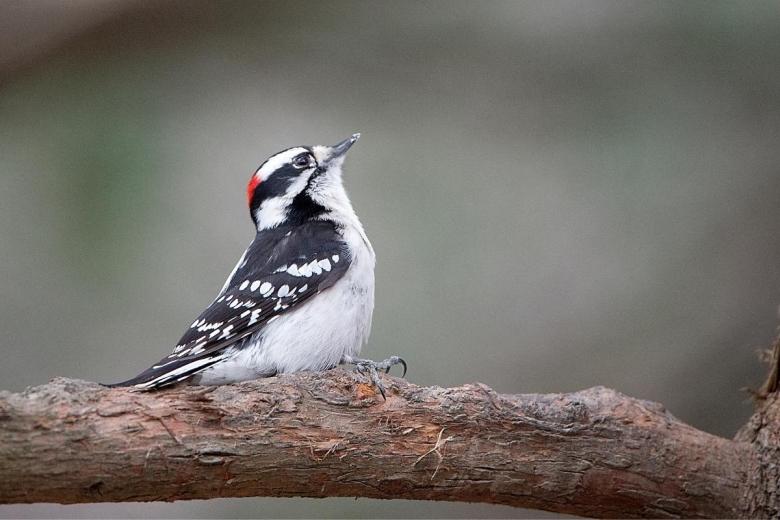
The Downy Woodpecker lives in Illinois year-round and nests between March and June, usually up to 50 feet above the ground. They have white and black wings, a white belly, and a black and white striped head. The male has a small but noticeable red spot on his head, which the female lacks. Both sexes grow 5.5 to 6.7 inches in length and weigh 0.7 to 1.0 ounces with a wingspan between 9.8 to 11.8 inches. They inhabit deciduous trees and brushy areas as well as parks and orchards feeding on insects, wasps, and caterpillars.
American Crow

The American Crow can be found throughout the state. They have long legs and a heavy bill with an entirely glossy black body. Both sexes grow to 15.8 to 20.9 inches and weigh 11.2 to 21.9 ounces with a wingspan between 33.5 to 39.4 inches. Woodlands, fields, and forests are their usual habitat, as well as parking lots, lawns, and fields. They will eat anything, which is why they also stay close to garbage dumps.
White-breasted Nuthatch
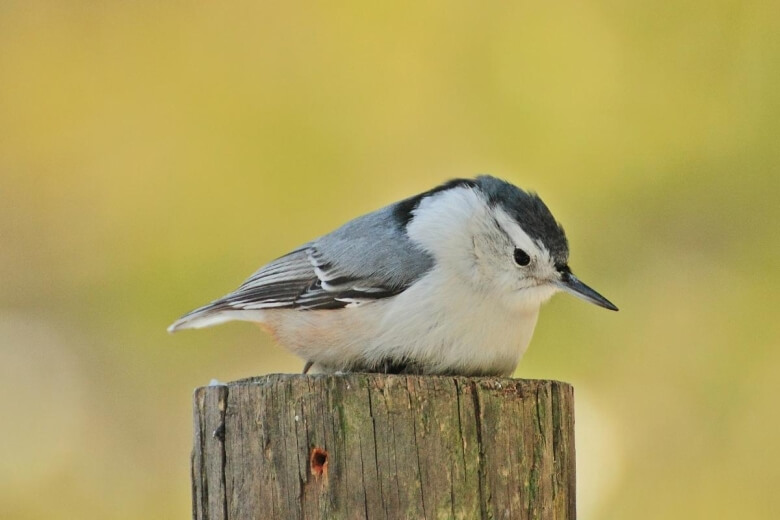
The White-breasted Nuthatch is in Illinois throughout the year and nests between April and May. They have grayish blue wings with a white underbelly and a face with a long black streak down the head to the neck. Sometimes, there is a brown hue on the lower tail and lower belly. Both sexes grow 5.1 and 5.5 inches in length and weigh 0.6 to 1.1 ounces with a wingspan between 7.9 to 10.6 inches. They live in forests, especially deciduous, and woodland edges where they snap up insects during the summer and supplement their diet with seeds in the winter.
Northern Cardinal
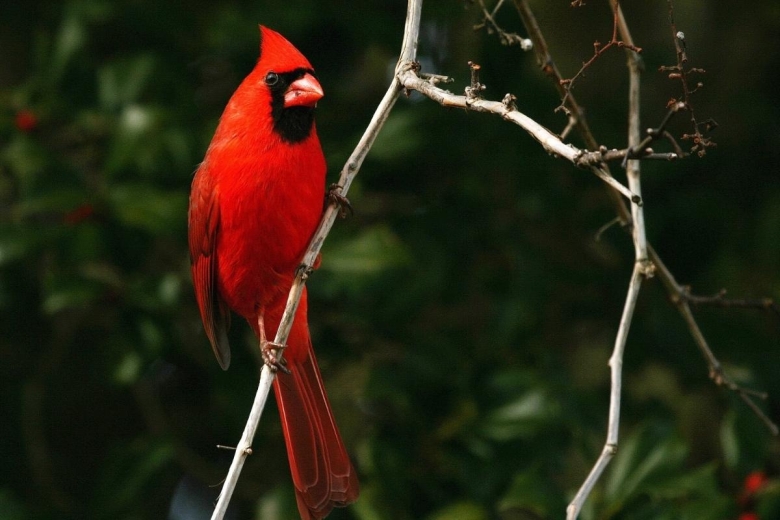
The Northern Cardinal is the state bird of Illinois and a glorious representative of its state. They are a large songbird with a long tail and a short, thick bill. The male is a vivid red with a black face, and the female is a tannish brown with red spots on the wings and tail. She does have the same type of black face. Both sexes grow 8.3 to 9.1 inches in length and weigh 1.5 to 1.7 ounces with a wingspan between 9.8 to 12.2 inches.
They inhabit parks, forest edges, and parks and feed on insects, berries, and seeds.
Red-winged Blackbird
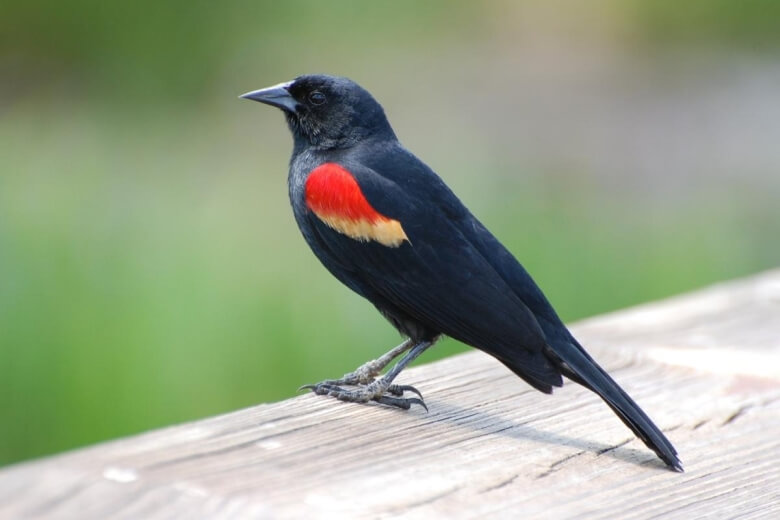
The Red-winged Blackbird resides in the state throughout the summer and can be found in southern and central Illinois during the winter. The male is glossy black with a red and yellow shoulder patch. Females are a streaked brown with a yellow streak by the bill. Both sexes grow 6.7 to 9.1 inches long and weigh 1.1 to 2.7 ounces with a wingspan between 12.2 and 15.8 inches.
They can be found near water and marches and sometimes in meadows and fields and feed on insects and seeds.
Black Birds in Illinois
Common Grackle
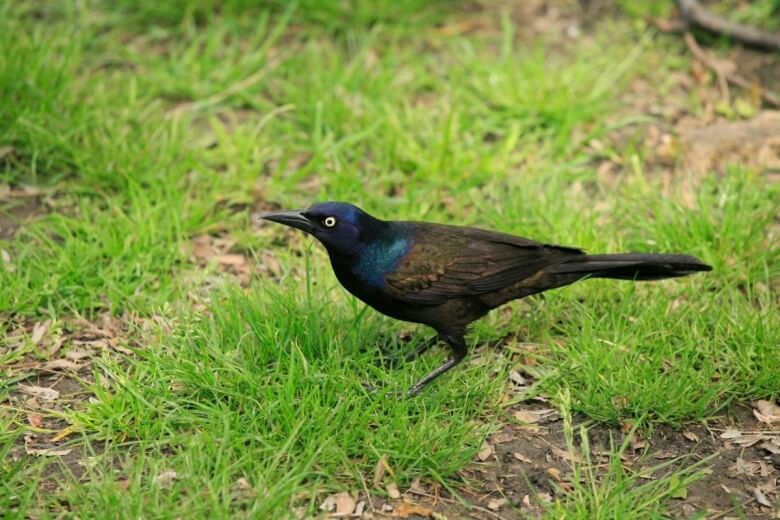
Common Grackle arrive in Illinois in February to prepare for breeding in the spring. They are a large blackbird with a long tail and a bill that curves downward. Their entire coloring is iridescent, shiny black with hints of purple and green throughout. The female looks similar but lacks some of the male’s gloss. Both sexes grow 11.0 to 13.4 inches in length and weigh 2.6 to 5.0 ounces with a wingspan of 14.2 to 18.1 inches. They forage for insects, earthworms, lizards, and bird’s eggs in parks, fields, and lawns, as well as meadows, marshes, and forest edges.
Bobolink

Bobolink arrives in Illinois in mid-spring to breed from May through June. It is a small blackbird with a large head and a short tail. The breeding male has a white back and rump, black and white streaked wings, and a black underbelly and tail. His head has a tanned nape. Both sexes grow 5.9 to 8.3 inches in length and weigh 1.0 to 2.0 ounces with a wingspan of 10.6 inches.
They live in grasslands, pastures, meadows, and fields and feed on insects, grains, and seeds.
Brewer’s Blackbird
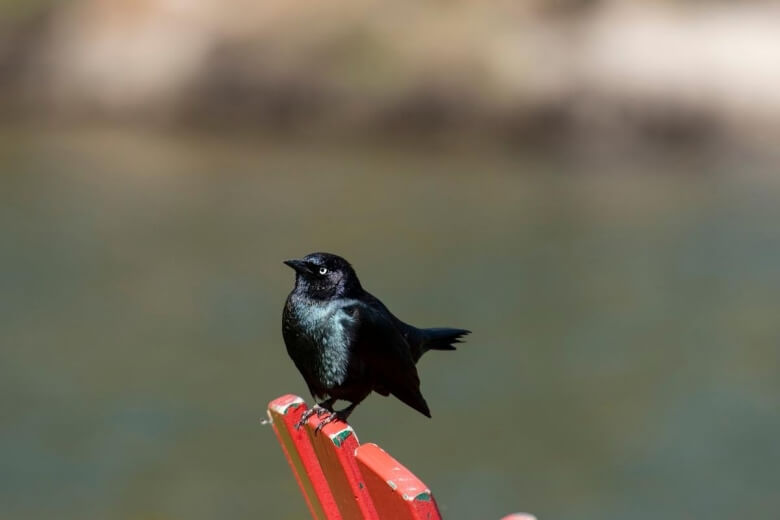
Brewer’s Blackbird can be spotted in southern Illinois in the winter and the northern part of the state in the summer. It inhabits fields, pastures, and marshes, and its main food are grains. The Brewer’s Blackbird has long legs and tail and a thick beak. The male is an overall glossy black with piercing yellow eyes while the female is brown with darker eyes. The male grows 8.3 to 9.8 inches in length and weighs 2.1 to 3.0 ounces with a wingspan of 14.6 inches.
Blue Birds in Illinois
Indigo Bunting
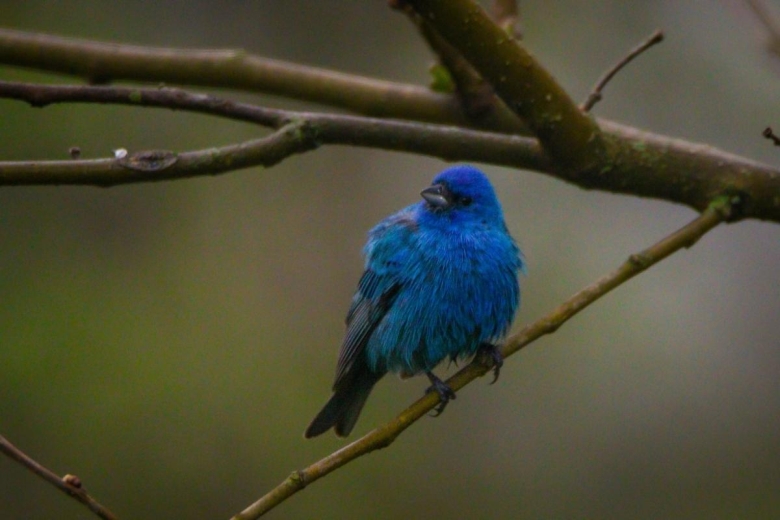
Indigo Bunting is in Illinois throughout the summer and sometimes in the winter in the state’s southern region. It is stocky with a short tail and a short, thick bill. The male is a gorgeous blue with a few thin gray stripes on the wings. The female is brown with a white throat. Both sexes grow 4.7 to 5.1 inches and weigh 0.4 to 0.6 ounces with a wingspan between 7.5 to 8.7. They inhabit brushy, shrubby areas and feed on every type of berry because these berries attract the insects (beetles, grasshoppers) that are their favorite food.
Blue-Gray Gnatcatcher
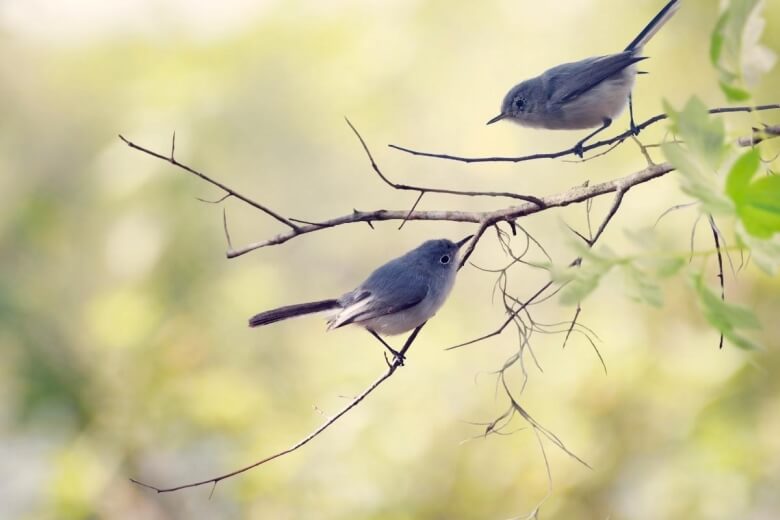
Blue-Gray Gnatcatchers begin their migration to Illinois in March and nest through June. They are small with long legs and tail and a thin bill. As the name implies, they are a shade of pale blue-gray with a whitish underbelly and a black tail. They both have a white circle around their eyes, but the black line on the male’s forehead gives him a frown. Both sexes grow to 3.9 to 4.3 inches in length and weigh 0.2 to 0.3 ounces with a wingspan of 6.3 inches.
The Blue-gray Gnatcatcher inhabits deciduous forests and grabs insects from the trees.
Tree Swallow
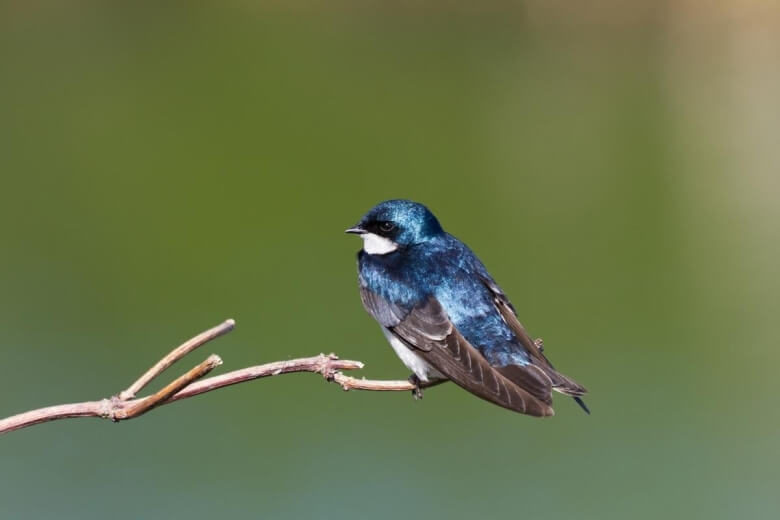
Tree Swallows can be spotted in northern Illinois during the summer. They have long, gray wings, and a blue back with a white underbelly. Their face has a distinctive black line over their eyes. Both sexes grow to 4.7 to 5.9 inches in length and weigh 0.6 to 0.9 ounces with a wingspan between 11.8 to 13.8. The tree swallow inhabits marshes and meadows, preferably near water. They feed on insects that they snap up while in flight.
Red Birds in Illinois
House Finch

House Finch can be found in Illinois year-round. They are small birds with a large beak and long legs. The male has a rosy, blushing face and breast, with brown streaks down the back, tail, and belly. The red rump can only be spotted when the male is in flight. Females lack the blush and are grayish brown, instead. They grow 5.1 to 5.5 inches in length and weigh 0.6 to 0.9 inches with a wingspan between 7.9 to 9.8 inches.
The House Finch inhabits parks, yards, farms, and forest edges. They eat a healthy diet of berries, fruits, vegetables, and small insects.
American Robin

American Robin spends the summers in Illinois, although some may remain for the entire year. They have a round body with long legs and tail. They are all-around gray-brown with an orange chest and white circles around the eyes. Both sexes grow 7.9 to 11.0 inches in length and weigh 2.7 to 3.0 ounces with a wingspan between 12.2 to 15.8 inches. They feed mostly on berries and insects but will also eat snails and spiders.
Scarlet Tanager
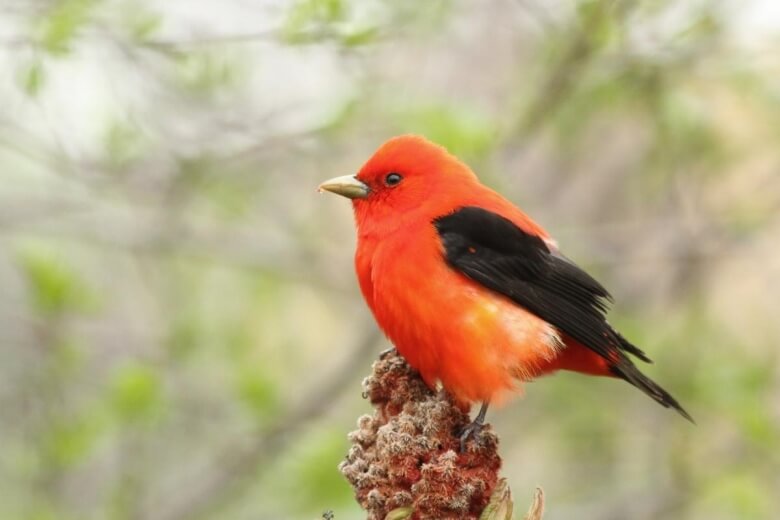
Scarlet Tanager can be seen in the northern part of Illinois. The migrants arrive during late spring and nest through August. They have a large head with a thick bill. The male is a vivid red with black wings and tail while the female is olive in color. They live high up deciduous trees and can remain well-hidden. They eat insects and fruits.
Orange Birds in Illinois
American Redstart
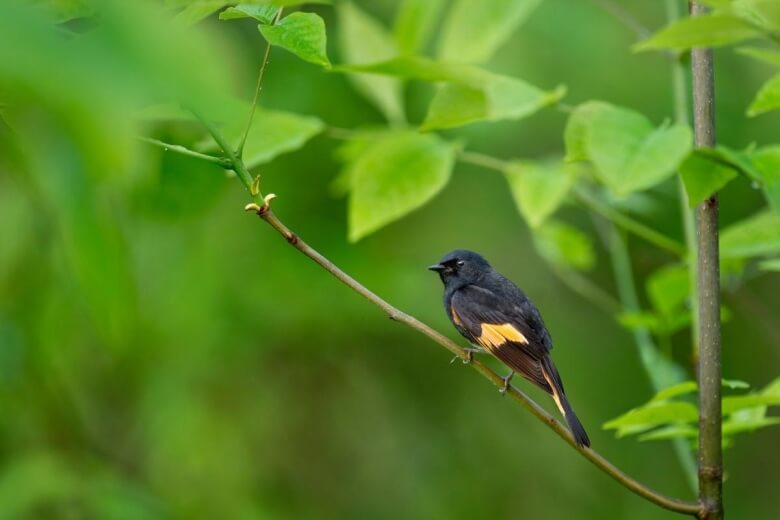
American Redstart migrates to Illinois in the summer. The males arrive in the spring to prepare for breeding throughout the summer. The male is black with oranges patches on its body; the underbelly is white. Females are gray with yellow markings. Both sexes grow to 4.3 to 5.1 inches and weigh 0.2 to 0.3 ounces with a wingspan between 6.3 to 7.5 inches. They inhabit any trees but prefer deciduous ones. The American Redstart feeds on insects and some seeds and berries.
American Kestrel
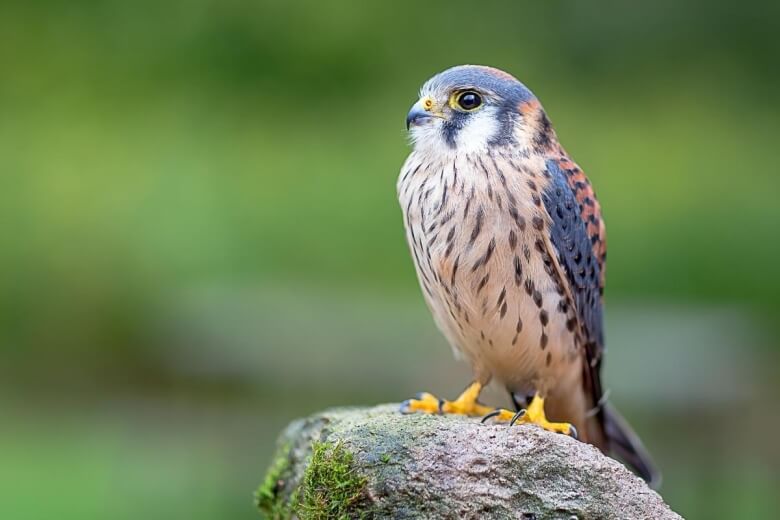
The colorful American Kestrel is a year-round resident of Illinois. They are rusty-orange with black spots and gray wings with the same spots. Both the male and the female have vertical lines across the face. Both sexes grow 8.7 to 12.2 inches in length and weigh 2.8 to 5.8 ounces with a wingspan between 20.1 to 24.0 inches. They live in both urban and suburban areas, frequently perched on high wires. They feed on small mammals, small birds, and insects.
Eastern Towhee

Eastern Towhee is an Illinois summer resident, although some remain throughout the winter, as well. The migrants arrive in February and nest from May through August. They have a chunky body with a long tail. The male is a bold black on top with an orange underbelly and white spots on the wings. The female is brown instead of black. Both sexes grow 6.8 to 8.2 inches in length and weigh 1.1 to 1.8 ounces with a wingspan between 7.9 and 11.0. They can be spotted around forest edges and brushy areas, where they feed on insects, lizards, snakes, berries, and small fruits.
Yellow Birds in Illinois
Eastern Meadowlark
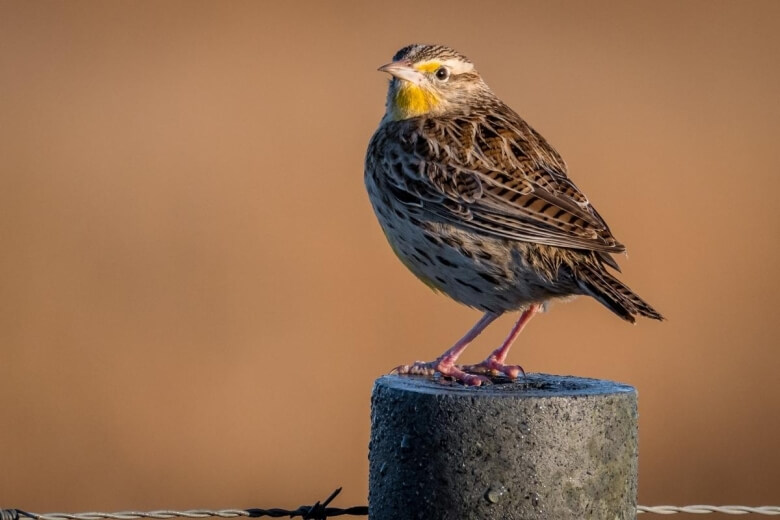
The Eastern Meadowlark migrates to Illinois during the summer and may spend the winter in the southern part of the state. They are chunky with short tails and long bills. They have a speckled brown top and a yellow belly and a black V across the chest. Both sexes grow 7.5 to 10.2 inches in length and weigh 3.2 to 5.3 ounces with a wingspan between 13.8 and 15.8 inches. The Eastern Meadowlark inhabits fields and perches on fences, utility lines, and trees. They feed on seeds, grains, and insects.
Black-throated Green Warbler
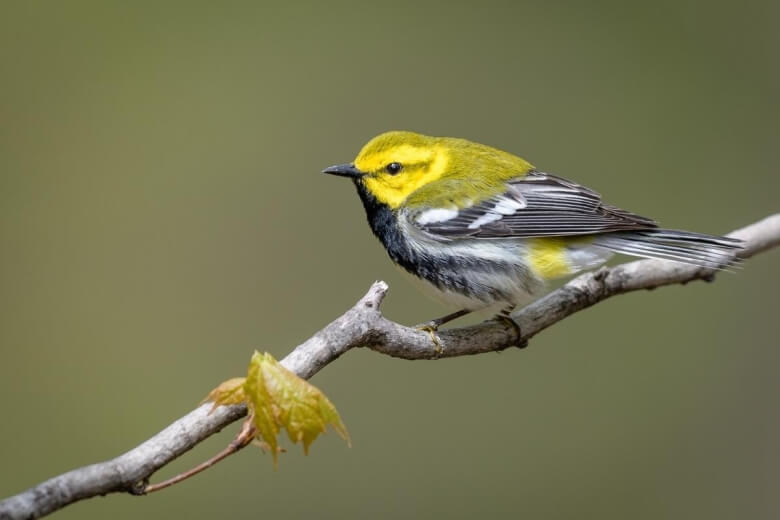
Black-throated Green Warbler can be found in Illinois’ woodlands during the spring and fall. They are plump with a large head, short tail, and a thick bill. They are olive-colored from the top of their head down their back with black and white striped wings and tail and a black throat. Their face is a vivid yellow with an olive streak. The female lacks the expressive black throat. Both sexes grow 4.3 to 4.7 inches in length and weigh 0.3 to 0.4 ounces with a wingspan between 6.7 and 7.9 inches.
They inhabit coniferous and deciduous forests, high up the canopy, where they feed mostly on insects.
Yellow-throated Warbler
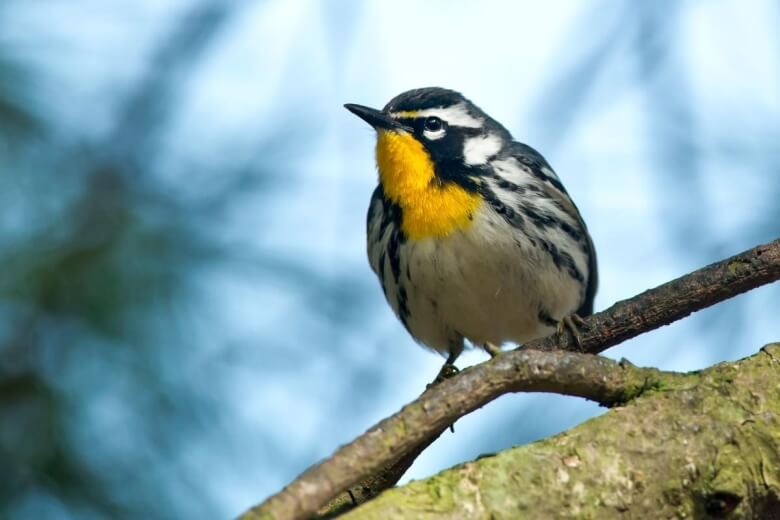
Yellow-throated Warbler migrates to Illinois beginning in early April, and some nest in southern Illinois. They have black and white wings and tail, a yellow throat, white eyebrows, and a pale underbelly. Both the male and female have the same coloring, but the female is a bit smaller in size. They grow 5.1 to 5.5 inches in length and weigh 0.3 to 0.4 ounces with a wingspan of 8.3 inches. The Yellow-throated Warbler lives in coniferous forests and swampy areas. They feed on insects, which they probe out of pinecones.
Common Birds of Illinois by Species
Finches in Illinois
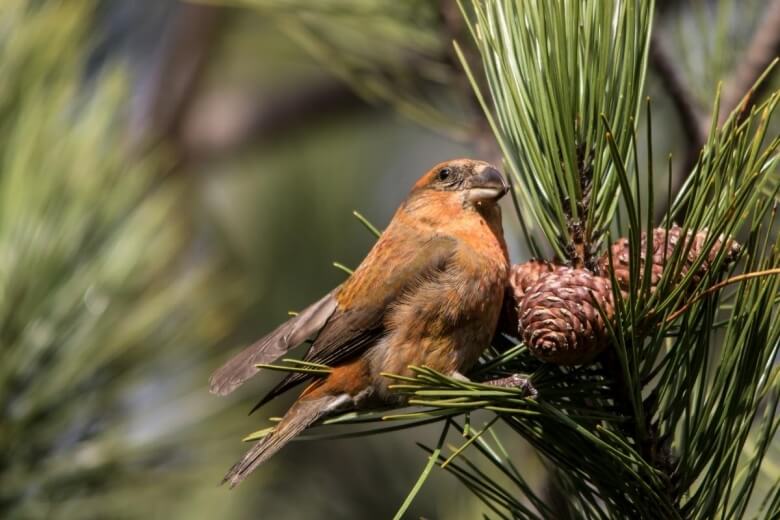
Red Crossbill – Loxia curvirostra – can be seen in Shawnee National Forest and in the vicinity of Chicago. They are short finches and are named after the bill which crosses when it is closed. Males are red with gray, pointed wings and tail. The female is brown with a yellow underbelly. They grow 5.5 to 7.5 inches in length and weigh 1.4 ounces with a wingspan between 10 to 11 inches. They inhabit conifer trees and feed on conifer seeds.
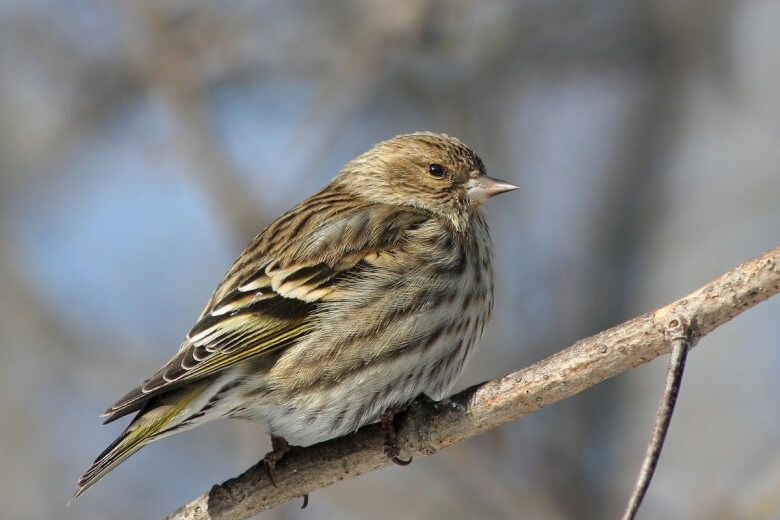
Pine Siskin – Spinus pinus – congregate in northern Illinois during the winter. They are small finches with a forked tail. They have brown and yellow streaks all over with a hint of yellow on the wings. They grow 4.3 to 5.5 inches in length and weigh 0.4 to 0.6 ounces with a wingspan between 7.1 and 8.7 inches.
The Pine Siskin inhabit deciduous forests and will forage in fields and gardens for pinecone seeds and nyjer and will visit bird feeders for sunflower seeds.

Purple Finch – Haemorhous purpureus – arrives in Illinois in September and continues to migrate in June. The male is raspberry-colored around the head with a paler shade of blush on the breast. His wings and tail are colorfully streaked reddish-brown. The female is white and brown streaked with a white belly. They grow 4.l7 to 6.3 inches in length and weigh 0.6 to 1.1 ounces with a wingspan between 8.7 to 10.2 inches. They inhabit coniferous and mixed forests feeding on insects, berries, and seeds. They can be lured to a birdfeeder with sunflower seeds.
Woodpeckers in Illinois
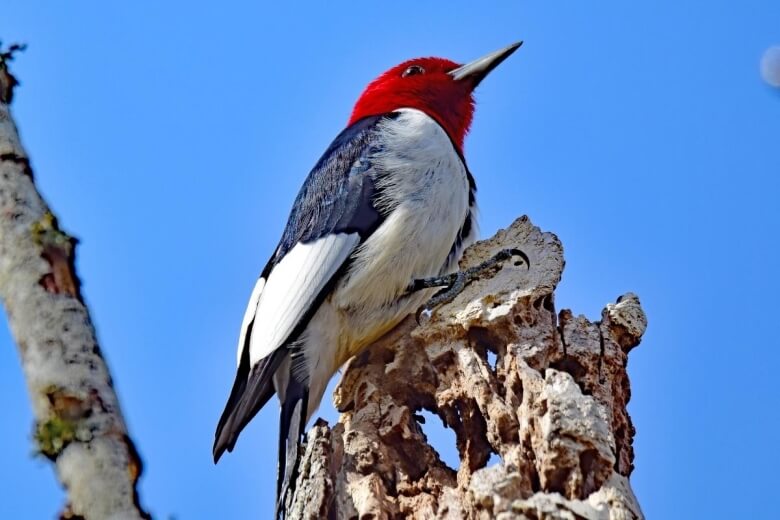
Red-Headed Woodpecker – Melanerpes erythrocephalus – can be found in Illinois year-round. They stand out with their vivid red heads, white bellies, and black wings. The epitome of elegance. The wings have white patches. They grow 7.5 to 9.1 inches in length and weigh 2.0 and 3.2 ounces with a wingspan of 16.5 inches. They live in open forests and hunt for insects on trees, in flight, and on the ground.
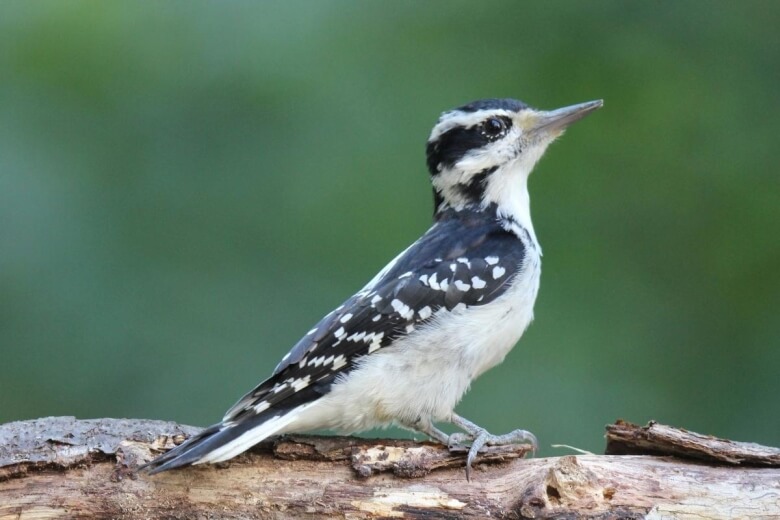
Hairy Woodpecker – Dryobates villosus – can be found year-round in Illinois forests, suburbs, orchards, and cemeteries and can easily be mistaken for the Downy Woodpecker, who is smaller but similar looking. They have a black and white striped body, white wings, black tails, and a black and white head with a red dot. They grow 7.1 to 10.2 inches in length and weigh 1.4 to 3.4 ounces with a wingspan between 13.0 to 16.1 inches. They forage through tree bark for insects.
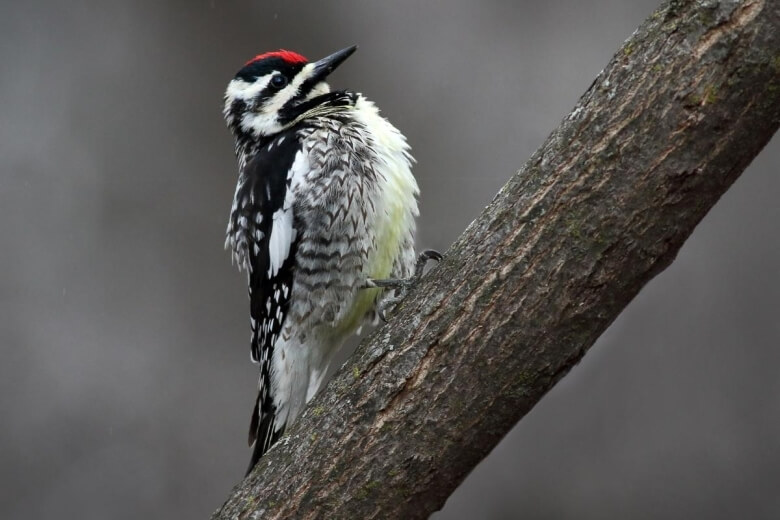
Yellow-Bellied Sapsucker – Sphyrapicus varius – is a summer resident woodpecker of northern Illinois, with the migrants arriving in early spring. They are stout and small, with black and white wings, a red face and throat with black and white stripes, and a pale, white or yellow, belly. They grow 7.1 to 8.7 inches in length and weigh 1.5 to 1.9 ounces with a wingspan between 13.4 and 15.8 inches. They inhabit forested areas and feed on tree sap, berries, and nut, and they are likely to visit a bird feeder for suet.
Hawks in Illinois

Sharp-shinned Hawk – Accipiter striatus – can be seen perched along Illinois’ roadways. They are small with a long tail and short wings. They are a patchy brown above, with an almost perfect white and brown geometric design on the belly, head, and throat. The eyes are a bright yellow. The male grows 9.4 to 13.4 inches in length and weighs 3.1 to 7.7 ounces with a wingspan between 16.9 and 22.1 inches. The female is slightly larger.
They breed deep within forests. These carnivores feed on other birds, squirrels, frogs, snakes, and other rodents.

Cooper’s Hawk – Accipiter cooperii – begin migrating to Illinois in February and nest through June. They are incredible fliers (possibly the best in the world) and will chase down other birds through a crowded forest canopy. They have broad, round wings and a long, rounded tail. Their wings and head are charcoal with a brown and white patterned underbelly and white rump. They live within forests as well as backyards. In addition to other birds, they prey on rodents.
The male grows 14.6 to 15.3 inches in length and weighs 7.8 to 14.5 ounces with a wingspan between 24.4 to 35.4 inches. The female is slightly larger.
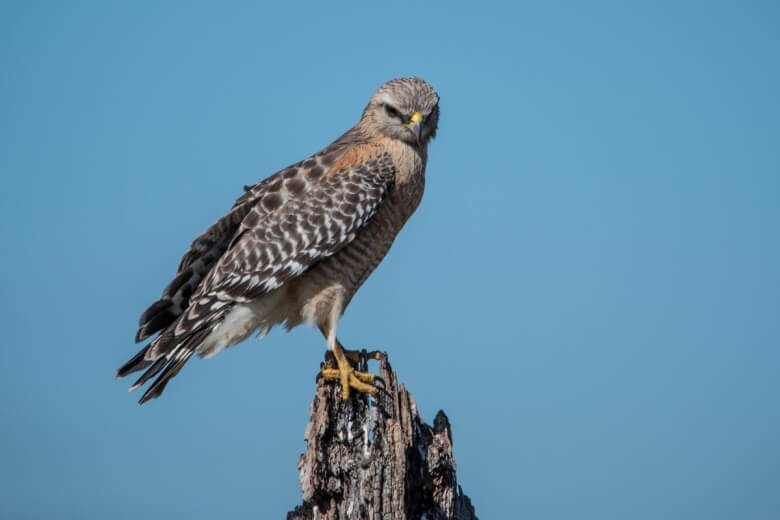
Red-shouldered Hawk – Buteo lineatus – begins its Illinois migration in early spring and nests through May. The male has brown and white patterned wings and rusty bars on the breast. The tail and underwings have noticeable white bands. They grow 16.l9 to 24.0 inches in length and weigh 17.1 to 27.3 ounces with a wingspan between 37.0 to 43.7. They live within forests and prey on small mammals and reptiles.
Further Reading on Illinois Birding
For more information on birding in Illinois, consider the following guidebooks:
- Retter, Michael L. P. (Author)
- English (Publication Language)
- Hayes, Lisa M (Author)
- English (Publication Language)
Birders can also check the following sources for more information:


